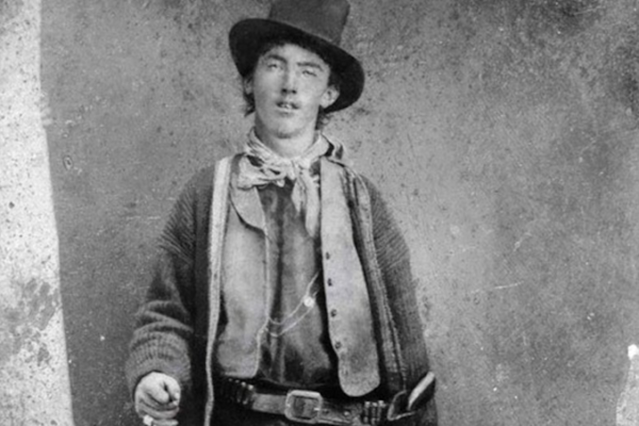I became interested in learning more about the historical town of Lincoln, New Mexico after I read an article that the state was going to invest $395,000 into preserving it.
From KRQE
A major preservation project is underway in an area of southern New Mexico that was once the stomping grounds of Billy the Kid and Sheriff Pat Garrett. Officials with the New Mexico Department of Cultural Affairs announced Thursday that the $395,000 project involves the Lincoln Historic Site, which is home to some of the most significant Territorial Period structures in the state. Many of the structures are under the protection of New Mexico Historic Sites. One of the six buildings included in the project is the Lincoln County Courthouse, best known as the location of Billy the Kid’s final escape in April 1881. Another is the John Tunstall Store, which was constructed in 1877 and stood at the center of the Lincoln County War. Adobe specialists are working to stabilize the building’s foundation to ensure that visitors can safely walk in the footsteps of Tunstall and the Regulators who were committed to avenging his death.
Work also is underway at the Montaño Store, San Juan Mission Church, Watson House and Brent House. Tim Roberts, deputy director of facilities and interpretation for New Mexico Historic Sites, said the community of Lincoln is one of the most well-preserved frontier towns in the western United States and provides a tangible link between New Mexico’s unique history and those who visit the site today.
About Lincoln, New Mexico
Lincoln is a town made famous by one of the most violent periods in New Mexico history. Today's visitors can see the Old Lincoln County Courthouse with museum exhibits that recount the details of the Lincoln County War and the historic use of the "House" as store, residence, Masonic Lodge, courthouse, and jail. Walk in the footsteps of Billy the Kid, Pat Garrett, and other famous and infamous characters of the Wild West. Trace the events of 1878 through the Courthouse and the Tunstall Store, with their preserved 19th-century atmosphere.
Remarkably, the Tunstall Store contains displays of the original 19th-century merchandise in the original shelving and cases! Continue your walk through history by visiting El Torreón (a defensive tower built by native New Mexican settlers in the 1850s), the San Juan Mission Church, the Convento, Dr. Woods' House, the Montaño store and other historic structures throughout the town. The Anderson-Freeman Visitor's Center & Museum features historical exhibits in a timeline starting with American Indian prehistory and ending with the Lincoln County War. A 22 minute video about the Lincoln County War and the community is shown every half hour.
The importance of this community and the significance of the Bonito Valley in the prehistory and history of the Territory of New Mexico are interpreted within some of the 17 structures that comprise Lincoln Historic Site. These historic adobe and stone buildings are preserved as they were in the late 1800s and represent the factions involved in the Lincoln County War, 1878-1881.
History:
Lincoln owes it's existence today to an infamous young man who became known as Billy the Kid. But long before Billy and the events of the Lincoln County War, this area was first home to a group of indigenous people called the Mogollon, followed by the Piros and later the Mescalero Apache.
When Spanish-speaking, Native New Mexican settlers from the upper Rio Grande began arriving in the 1850s, the named their new home La Placita del Rio Bonito (the place by the pretty river). In 1869, just four years after the end of the Civil War, the county and town were renamed for the late President, Abraham Lincoln.
In 1873, L.G. Murphy established a store in Lincoln known as "The House" because of it's monopoly over commerce in the county. When an enterprising young Englishman named John Tunstall arrived in Lincoln and opened a rival store and a bank, the autocracy of The House was threatened. Additionally, Tunstall, along with his business partners, Attorney Alexander McSween and John Chism, planned to challenge Murphy's domination of the beef market supplying nearby indian reservations and forts such as Fort Stanton.
President Rutherford B. Hayes called Lincoln’s main street “the most dangerous street in America.” In this quiet one-street community visitors can walk in the footsteps of Sheriff Pat Garrett, Billy the Kid, and other infamous characters involved in the Lincoln County War, 1878-1881.
The Old Lincoln County Courthouse traces the events as a store, residence, Masonic Lodge and eventually courthouse and jail.
The Tunstall Store's original 19th century merchandise is on display.
The Torreon, a defensive tower, continues to stand watch in the middle of town.
The Montano Store contains exhibits on adobe construction and the Hispanic culture that was prevalent during the Lincoln County War.
The San Juan Mission Church is open to the public and is still used for services today.
The Anderson-Freeman Visitors Center, the only non-historical building open to the public, has exhibits in a timeline starting with American Indian pre-history and ending with the Lincoln County War.
Special events are scheduled throughout the year.
Check Out:

















No comments:
Post a Comment